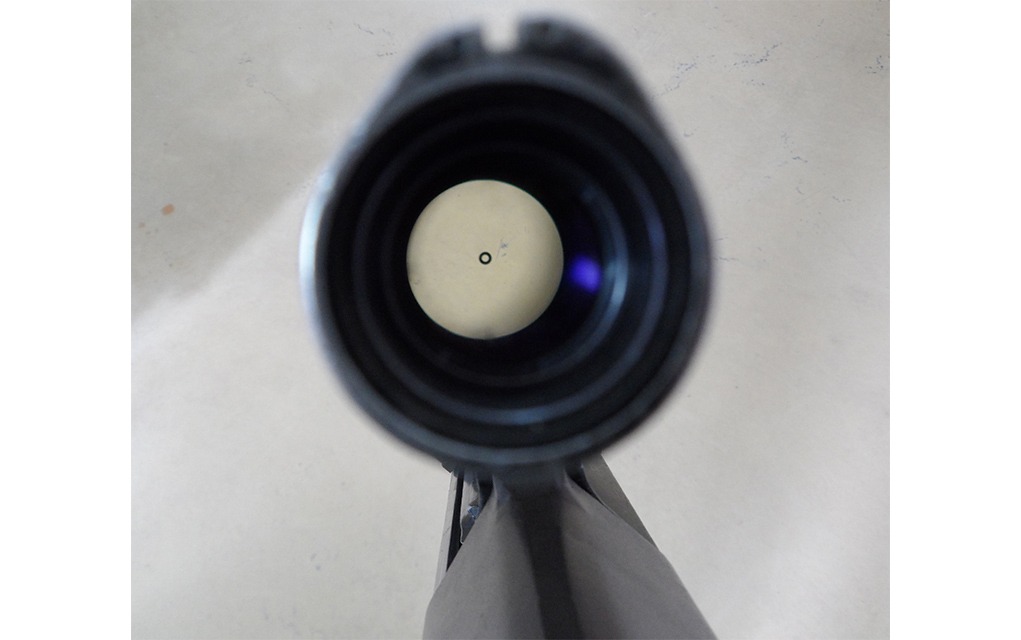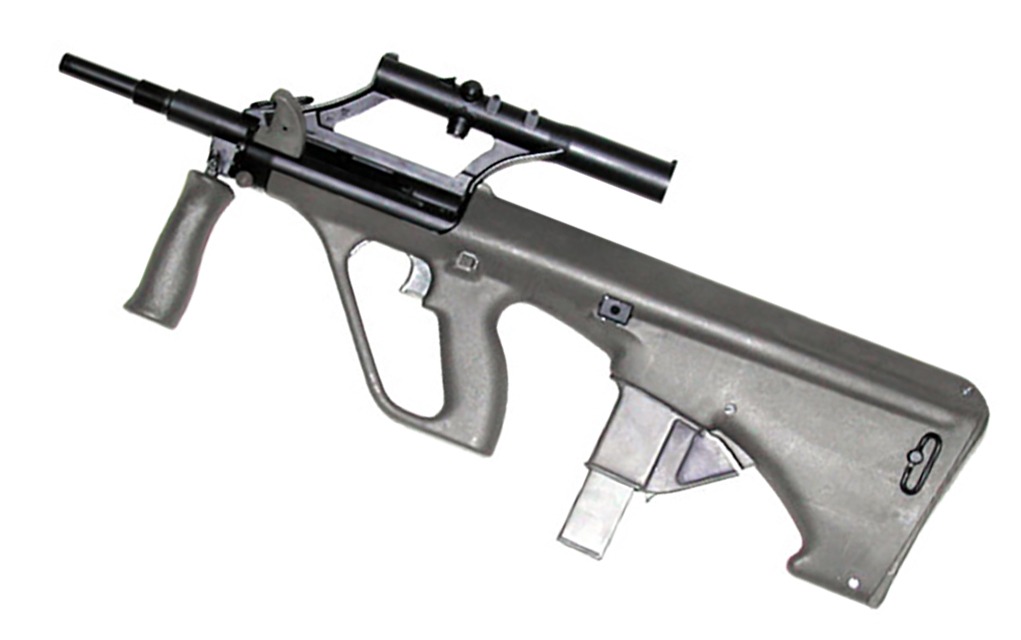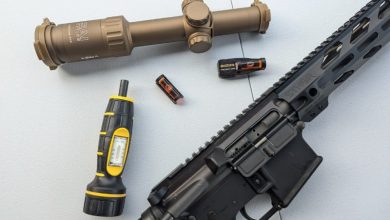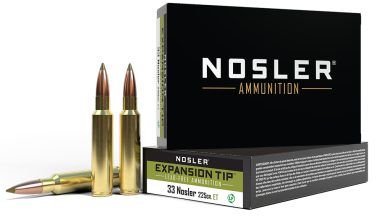We take a deep dive into the Steyr AUG, possibly the most iconic bullpup military rifle ever built.
You probably remember the first time you laid eyes on a Steyr AUG. When most people do, they either love it or hate it. With its bullpup layout, green polymer stock and integrated optic, it still looks as futuristic today as when it was first released in the late 70s. The AUG wasn’t the first bullpup rifle, but it’s one of the most successful versions ever to be fielded and almost certainly the most famous and recognizable of the bunch. So, here we’ll discuss the history, design, function and legacy of the Steyr AUG.
Steyr AUG A1 Specs:
Cartridge: 5.56x45mm NATO
Action: Gas-operated rotating bolt short-stroke piston
Capacity: 30- or 42-round proprietary magazines
Barrel Length: 20 inches
Weight: 7.9 pounds
Overall Length: 31.1 inches
Sights: Swarovski Optik 1.5x scope ; backup illuminated 3-dot iron sights
Origins Of The AUG
Designed in the 1960s with production beginning in 1977, the Steyr Armee-Universal-Gewehr (Army Universal Rifle) or AUG, pronounced “A-U-G” (some incorrectly pronounce it as “awg”), featured a polymer stock body that housed the action and magazine well rear of the trigger, a radical departure from traditional rifle designs. Another detail that made the AUG stand out among its contemporaries like the AK and the M16 was the fact that it featured an integrated optic. Introduced at a time when iron sights were still the norm on military rifles, this was a very forward-thinking concept.
The Austrian Army adopted the AUG as the Sturmgewehr 77 or StG77 in the late 1970s to replace its aging FN FAL rifles chambered for 7.62 NATO. Transitioning from a full-power cartridge to the AUG’s intermediate 5.56x45mm was a big step toward modernization on its own, but it was the rifle’s other features that set it apart on the world stage.

It didn’t stand up there alone, however, as the world was experiencing a bit of a bullpup craze in this period. The French adopted the FAMAS at about the same time as the Austrians did the AUG, and the British were working on developing the SA80 that would enter service a few years later in 1985. However, the AUG distinguished itself with its extensive use of polymer and its integrated optic.
For these reasons, combined with Steyr’s reputation for excellent quality, the AUG was easily the most successful of these three prolific Cold War bullpup designs. While the French and British rifles saw some limited international use, mostly with ex-colonial possessions, both pale in comparison to the number of military and law enforcement groups that have adopted the AUG over the years.
Outside of its home country of Austria, New Zealand, Australia, Ireland, Argentina and several other nations have all adopted the AUG as their primary service rifle, and many more special forces and law enforcement agencies around the globe have procured them as well. A further testament to the design’s success is that it has been produced under license in Australia, Malaysia, South Korea and India for official military use as well as in the U.S. by Steyr Arms USA for the American civilian market.


Steyr AUG Function And Features
The Steyr AUG is innovative for many reasons. First is it use of polymers, which are incorporated extensively throughout the design from the stock housing to the trigger group to the oversized trigger guard that protects the user’s entire hand.
Internally, the AUG features a rotating bolt with dual recoil guide rods like the AR-18. As a closed-bolt, gas-operated short-stroke piston system with a non-reciprocating charging handle, its action may be pretty conventional, but its bullpup layout meant that it could have a standard barrel length of 20 inches with an overall length of just 31.1 inches. That’s a lot of barrel length tucked into a small package. By comparison, an M4 has a 14.5-inch barrel and an overall length of 33 inches with the stock fully extended.
The rifle’s overall length could be reduced even further thanks to its unique quick barrel change system. Remember the long-haired bad guy in the first Die Hard movie? He assembled his AUG almost as fast as Bruce Willis loaded and racked his Beretta 92. A quick-change barrel can be useful for several reasons, but one advantage is modularity as Steyr offers various barrel lengths for the system. Whether you need a shorter barrel for breaching a building or a longer, heavier barrel with a bipod to lay down some lead, the AUG can be switched to any given configuration by just twisting the barrel by the vertical grip, pulling it out and reversing the process to install a new barrel.


The original AUG used a proprietary magazine made of a translucent polymer with a waffle texture which came in either a 30- or 42-round capacity. However, newer variants typically use stocks designed to accept STANAG AR-15-pattern magazines. These more modern AUG models also feature a bolt release, whereas the original models required the user to release the bolt via the charging handle.
As for the AUG’s controls, they are few and simple. The magazine release is located behind the magazine. The safety is located on the side of the rifle behind the trigger and is operated by pushing it through the stock body. It, too, is made of polymer. There is no select-fire lever like on an AR-15, as the AUG features a progressive trigger instead. This means that a short pull will result in a single shot and a full trigger pull will result in automatic fire.


The final, but perhaps most impressive feature of the original AUG was its integrated optic. It was manufactured by Swarovski Optik and featured a 1.5x magnification with a black donut-style reticle. While it was very durable, no optic is indestructible, so backup iron sights were added to the top of the scope body as well. Of course, modern AUG variants come with Picatinny rail instead so the user can add an optic model of their choice. That said, for the infantrymen of the era, being given a rifle with a 1.5x power optic and a relatively modern-style reticle was a big advantage.
Major AUG Variants
Between all the different countries and militaries to produce and use the AUG, there are a lot of minor variants in existence. Here, we’re only going to briefly cover the major updates and versions from Steyr itself.
The AUG has received a few minor tweaks since 1977, but besides some modernization features the rifle has remained mostly unchanged. The most major change between the original A1 and the A2 version, which debuted in 1997, was the addition of a detachable optic that can be swapped for a Picatinny rail allowing the user to mount a wider variety of optics.
The A3 model integrated the Picatinny rail with the top of the receiver along with some other modernization features like the addition of an external bolt release.


Outside of rifle configurations, Steyr also made LMG and SMG versions of the AUG.
For the LMG option, the AUG HBAR (Heavy Barreled Automatic Rifle) was given a heavier and longer 24.4-inch barrel with an integrated bipod. Another unique feature of this variant is that it fires from an open bolt to help with sustained fire.


For the SMG variant, Steyr made the AUG 9mm, both as a factory option and as a conversion kit for standard 5.56 rifles. Either way, 9mm AUGs feature shorter barrels that replace the traditional gas system with a simple blowback action. These have been adopted by a handful of police units around the world, but they’re nowhere near as popular as the 5.56 rifle.


Owning An AUG
Everyone knows that bullpups have both pros and cons, and whether you like them or not really boils down to personal preference. If you’re a bullpup fan, the AUG is thankfully readily available today on the civilian market.
Is it the best bullpup available? Many believe that to be the case. While there are plenty of newer bullpup rifles on the market today, like the IWI Tavor and the Springfield Hellion, it’s hard to argue with the tried-and-true reputation of the AUG.
If you’re a military rifle collector looking for an original pre-ban A1 model with an integrated optic, you’re going to have a harder time finding one and it will cost you a pretty penny. However, if you just want a shooter and are looking for one of the newer models there’s never been a better time to buy one. This is because Steyr began manufacturing the AUG in the U.S. a few years ago and it’s resulted in prices dropping across the board. Models like the A3 M1 have been available for as low as $1,500 when on sale, and while that’s still relatively expensive, they’ve never been this affordable in the U.S. before. As a bonus, Steyr recently started offering .300 BLK variants as well.
The AUG Legacy
The Steyr AUG may not have been the first bullpup, nor the first one with a polymer housing, nor the first combat rifle with a standard integrated optic, but it blended several good ideas of its time to create a very forward-thinking, advanced combat rifle. Despite this, after the bullpup craze died down after the 1980s, it never overshadowed the global popularity of traditional rifle designs. As far as bullpups go, however, the AUG was extremely successful.
Not only was it a commercial success with its large number of international sales and use by various military and law enforcement groups, but it was a cultural success as well. This is despite the fact that, while it has seen action, the AUG never became closely associated with any conflict it took part in. Today, even non-gun people who don’t know what “bullpup” means will likely recognize its unique form, and they might even be able to name some movies they’ve seen one in like Die Hard or the countless sci-fi films that used them as generic futuristic-looking firearms.
While the AUG will never be as prolific as some other military rifles, it’s earned its place as a historically significant design and the nations that use them aren’t likely to replace them any time soon.
Pros
- Good ballistics in compact package
- Reliable, rugged, proven design
- Newer models are readily available
- Quick-change barrel for stowage or modularity
Cons
- Different manual of arms than a traditional rifle, will need to learn new reloading methods etc.
- Proprietary magazines unless model in question is a “NATO” version
- Can’t adjust length of pull
- Relatively expensive
Steyr AUG Deals
More Classic Military Guns:


Next Step: Get your FREE Printable Target Pack
Enhance your shooting precision with our 62 MOA Targets, perfect for rifles and handguns. Crafted in collaboration with Storm Tactical for accuracy and versatility.
Subscribe to the Gun Digest email newsletter and get your downloadable target pack sent straight to your inbox. Stay updated with the latest firearms info in the industry.
Read the full article here





